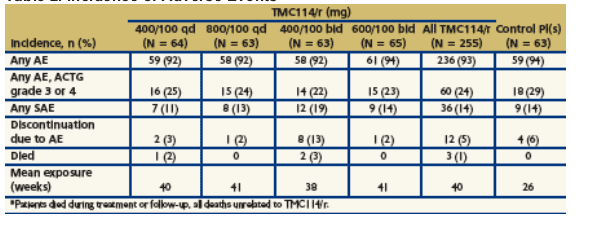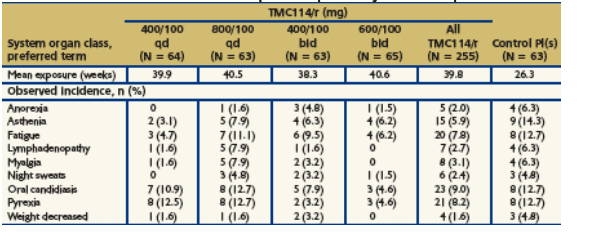 |
 |
 |
| |
TMC114/r is well tolerated in 3-class-experienced patients: Week 24 primary safety analysis of POWER 1 (TMC114-C213)
|
| |
| |
Reported by Jules Levin
3rd Intl AIDS CSociety Conference
Rio de Janeiro
July 24-27, 2005
This is poster presented at Rio by Tibotec.
B Grinsztejn1, K Arasteh2, B Clotet3, CA Cunha4, JC Goffard5, S Spinosa Guzman6, A Hill6, JM Molina7, C Tanski6, H Walgraeve6
1Instituto de Pesquisa Clinica Evandro Chagas-Fiocruz, Brazil; 2Vivantes Auguste-Viktoria-Klinikum, Berlin, Germany; 3University Autónoma de Barcelona, Spain;
4Hospital de Clinicas-UFPR, Curitiba, Brazil; 5Hopital Universitaire Erasme, Brussels, Belgium; 6Tibotec BVBA, Mechelen, Belgium; 7Hopital Saint-Louis, Paris, France
AUTHOR CONCLUSIONS:
--In 3-class-experienced patients TMC114/r was:
-generally well tolerated, with no apparent dose relationship for AEs
-associated with a low rate of treatment discontinuation
-associated with an incidence of laboratory abnormalities comparable to control PI(s).
-associated with a reduction of constitutional symptoms commonly observed with HIV disease.
ABSTRACT
Objectives: To determine the safety and tolerability of TMC114/ritonavir (TMC114/r) in a randomized, controlled, international, multi-center
phase IIb efficacy/safety trial.
Methods: Three-class-experienced patients on stable PI-therapy (with 3 1 primary PI mutation and VL > 1,000 copies/mL) were randomized to receive one of four TMC114/r doses, or investigator-selected PI(s), together with an optimized background regimen (OBR).
Results: During study (N = 318), 62% of controls discontinued, 54% for virologic failure and 6% for adverse events (AEs). Ten percent of TMC114/r patients discontinued, 5% for AEs. The incidence of serious AEs was comparable for TMC114/r and control groups (14%). Most AEs and laboratory abnormalities were mild-to-moderate in severity with similar incidence across all groups:

The three most common AEs are presented below for TMC114/r 600/100 mg bid, the dose selected for treatment-experienced patients, together with an analysis per 100 patient years of exposure (to adjust for shorter drug exposure in controls resulting from discontinuation):

The safety profile in HCV/HBV-HIV co-infected patients (N = 31/255, TMC114/r vs 13/63 for control PI[s]) was comparable to the overall study population.
Hepatitis C and hepatitis B co-infected patients (see table below)
--The safety profile in HCV/HBV-HIV co-infected patients (N = 31/255 of all TMC114/r patients versus 13/63 for control Pl[s[) was comparable to the overall study population.
--One grade 3 and one grade 4 elevation in GGT were observed in the TMC114/r groups for this subpopulation. In the control group, one grade 3 increase in AST and one grade 4 liver function test abnormal were reported as AEs. No AEs classed as ‘Hepatobiliary Disorders’ were reported in these patients.
Conclusions: In 3-class-experienced patients, TMC114/r was generally well tolerated and there was no apparent dose relationship in AE incidence. The incidence of AEs of all grades was similar for TMC114/r and controls. When corrected for drug exposure, the incidence of the most common AEs was lower than for control PI(s).
RESULTS
Patients
--At baseline, TMC114/r and control groups were comparable for demographic, disease severity and prior treatment characteristics (Table 1).
Table 1. Baseline Characteristics of all the patients

Discontinuation and exposure
--Sixty-two percent of controls discontinued; 54% of controls discontinued for virologic failure and 6% for adverse events (AEs).
--Ten percent of TMC114/r patients discontinued; 5% for AEs. Two of the twelve discontinuations were for GI-related AEs (diarrhea).
--The higher rate of discontinuation in the control arm meant that patients in this group had considerably less exposure (mean 26 weeks)
to their drug regimens than those in the TMC114/r study arms (mean 40 weeks).
Adverse events
--The incidence of AEs was comparable across treatment groups with no dose relationship (Table 2).
--Apart from injection site reaction, the two most common treatment-emergent AEs in the TMC114/r group were headache (17%) and diarrhea (16%). Injection site reaction observed with ENF administration was reported by 28% of the TMC114/r-treated patients (a total of 44% of TMC114/r patients received ENF during the study). The incidence of these events was similar for the TMC114/r and control groups, except for diarrhea which was higher for the controls.
--Special attention was given to the following AEs of interest: rash-related, cardiac-related and liver-related events, and those related to lipid and glucose metabolism. Overall, these AEs occurred with a similar frequency in the TMC114/r and control groups.
--Overall, 14% of patients in the TMC114/r and control groups reported at least one serious AE (SAE) during the treatment period (Table 2).
The most common SAEs were pneumonia and headache, both reported in 3 (1%) patients in the TMC114/r groups and not in the control group.
--Three patients randomized to TMC114/r died (Table 2). Causes of death were multi-organ failure, megacolon-acquired and progressive multifocal leukoencephalopathy. Additionally, a fourth fatal case was reported in the control group, however this case was reported 2 weeks post follow-up. All these deaths were considered by the investigator to not be related to TMC114/r or the investigator-selected PI regimen (control group). No dose-relationship with TMC114/r was observed.
Table 2. Incidence of Adverse Events

--When adjusted for exposure to treatment, patients receiving TMC114/r-based therapy tended to have a lower incidence of AEs than controls (Table 3).
--Adjusting for the extent of treatment exposure, the three most common AEs of diarrhea, nausea and headache, occurred less frequently for the TMC114/r group than for the control group (18, 14, 18/100 patient-years vs 57, 25, 47/100 patient-years, respectively).
Table 3. Constitutional symptoms commonly observed with HIV disease: observed incidence and incidence per 100 patient years of exposure

Laboratory values
--Changes from baseline in most laboratory parameters were small, not clinically relevant and occurred with similar incidence across all groups (Table 4, Figure 1). Concomitant serum lipid-reducing agents were used by 21% of all TMC114/r patients and 29% of controls.
--Minor median changes were reported for vital signs and ECG parameters. Some statistically significant changes were observed for certain parameters but no trends or relationship to dose were apparent. Individual treatment-emergent abnormalities in vital signs were reported with a similar incidence in the TMC114/r groups and in the control group. Overall, QTc abnormalities were more commonly reported in the control group than in the TMC114/r groups. No clear dose relationship was observed in the TMC114/r groups.
Table 4. Enhanced ACTG-graded laboratory abnormalities emerging in the treatment period (worst toxicity grades)

INTRODUCTION
--TMC114 is a new, investigational HIV protease inhibitor (PI) with potent in vitro activity against a broad range of HIV strains, including those resistant to commonly used PIs.1,2
--With TMC114, emergence of resistant HIV strains from wild-type virus in vitro is much slower compared with other PIs.2
--TMC114 has a unique chemical structure allowing a precise fit into the substrate consensus volume of HIV protease. This precise fit and the flexibility of TMC114 binding may render it less susceptible to mutations that confer Pl resistance.3,4
--Two phase IIb, randomized, controlled, international multicenter trials have been designed to investigate the efficacy and safety of TMC114 with low-dose ritonavir (TMC114/r) in 3-class-experienced, HIV-1-infected patients. This poster presents the results of a Week 24 primary safety analysis of the phase IIb randomized study, POWER 1 (TMC114-C213).
--Results from the Week 24 primary efficacy analysis show that, when combined with low-dose ritonavir and an optimized background regimen (OBR = at least two NRTIs), TMC114/r is associated with significantly improved outcomes compared with a control group comprising investigator-selected, PI-based standard-of-care regimens.5 The difference from control remained with or without the addition of enfuvirtide (ENF).
--Best outcomes at Week 24 were observed for TMC114/r given at 600/100 mg bid and include:
-77% of TMC114/r patients vs 25% of control patients achieved 3 1 log10 viral load reduction (ITT TLOVR analysis, p < 0.001)
-superior mean viral load reduction (-2.03 vs -0.63, non-completer = failure analysis [NC = F], p < 0.001)
-higher proportion with HIV-1 RNA suppressed below 50 copies/mL = 53% vs 18%, ITT TLOVR analysis, p < 0.001)
--greater increase in CD4 cell count (124 cells/mm3 vs 20 cells/mm3, LOCF analysis, p < 0.001).5
Figure 1. Mean change in triglycerides (A) and total cholesterol/HDL (B) over time

METHODS
Patients and study design
--A randomized, controlled, partially blinded phase IIb trial to evaluate:
-the dose-response relationship of antiviral activity between four TMC114/r treatment groups at Week 24, compared with control PI(s)
-the safety, tolerability and the durability of antiviral activity of TMC114/r compared with the control arm.
--Target enrolment was 300 HIV-1 infected patients:
-male or female patients aged 3 -18 years
-3-class-experienced (defined as prior treatment with >/=2 NRTIs for at least 3 months in total and >/=1 NNRTI in a failing regimen, and
treatment with at least one PI for at least 3 months)
-stable PI-containing regimen for at least 8 weeks prior to screening
-3 1 primary PI mutation (any combination, IAS-USA guidelines, March 2003) at screening
-plasma HIV-1 RNA > 1,000 copies/mL
-no CD4 cell count restrictions
-co-infection with Hepatitis B or C allowed.
--Patients were randomized to receive OBR and either investigator-selected PI(s), or TMC114/r 400/100 mg qd, 800/100 mg qd, 400/100 mg bid or 600/100 mg bid.
--The primary endpoint was the proportion of patients with >/= 1 log10 viral load decrease at Week 24*. All analyses were intent-to-treat.
--An enhanced ACTG grading severity list was used to categorize AEs and laboratory abnormalities (Division of AIDS table for grading severity of adult adverse experiences, August 1992).
*Amended primary objective of trial. The original primary objective (to evaluate the relationship between TMC114/r dose and antiviral response at Week 24) was changed following a meeting with the FDA.
References
1. De Bethune MP, Wigerinck P, Jonckheere H, et al. TMC114, a highly potent protease inhibitor (PI) with an excellent profile against HIV variants highly resistant to current PIs. Presented at: Interscience Conference on Antimicrobial Agents and Chemotherapy; December 16-19, 2001; Chicago, IL. Abstract 1677.
2. De Meyer S, Azjin H, Surleraux D, et al. TMC114, a novel human immunodeficiency virus type 1 protease inhibitor active against protease inhibitor-resistant viruses, including a broad range of clinical isolates. Antimicrob Agents Chemother 2005;49:2314-2321.
3. Tie Y, Boross PI, Wang YF, et al. High resolution crystal structures of HIV-1 protease with a potent non-peptide inhibitor (UIC-94017) active against multi-drug-resistant clinical strains. J Mol Biol 2004;338:341-352.
4. King NM, Prabu-Jeyabalan M, Nalivaika EA, Wigerinck P, de Bethune MP, Schiffer CA. Structural and thermodynamic basis for the binding of TMC114, a next-generation human immunodeficiency virus type 1 protease inhibitor. J Virol 2004;78:12012-12021.
5. Katlama C, Carvalho MTM, Cooper D, et al. TMC114/r outperforms investigator-selected PI(s) in 3-class-experienced patients: Week 24 primary analysis of POWER 1 (TMC114-C213). Presented at: 3rd IAS Conference on HIV Pathogenesis and Treatment; July, 24-27, 2005; Rio de Janeiro, Brazil. Abstract WeOaLB0102.
|
|
| |
|
 |
 |
|
|